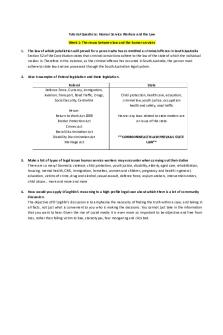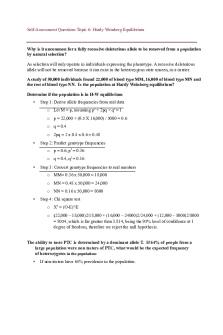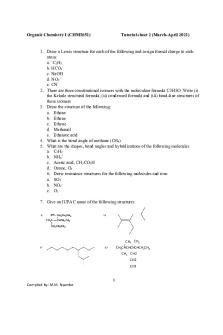Tutorial 10-Solutions PDF

| Title | Tutorial 10-Solutions |
|---|---|
| Author | Wong Kai Jeng |
| Course | Information And Network Security |
| Institution | Monash University |
| Pages | 3 |
| File Size | 115.2 KB |
| File Type | |
| Total Downloads | 487 |
| Total Views | 829 |
Summary
FIT3031 TUTORIAL 10 SOLUTIONS MALICIOUS SOFTWARE REVIEW Q1. What is the role of encryption in the operation of a virus? Ans: A portion of the virus, generally called a mutation engine, creates a random encryption key to encrypt the remainder of the virus. The key is stored with the virus, and the mu...
Description
FIT3031 TUTORIAL 10 SOLUTIONS MALICIOUS SOFTWARE REVIEW Q1. What is the role of encryption in the operation of a virus? Ans: A portion of the virus, generally called a mutation engine, creates a random encryption key to encrypt the remainder of the virus. The key is stored with the virus, and the mutation engine itself is altered. When an infected program is invoked, the virus uses the stored random key to decrypt the virus. When the virus replicates, a different random key is selected.
Q2. What are the typical phases of operation of a virus? Ans: A dormant phase, a propagation phase, a triggering phase, and an execution phase
Q3. In general terms, how does a worm propagate? Ans : 1. Search for other systems to infect by examining host tables or similar repositories of remote system addresses. 2. Establish a connection with a remote system. 3. Copy itself to the remote system and cause the copy to be run.
Q4. Desc ribe some worm counterm easures. Signature-based worm scan filtering: This type of approach generates a worm signature, which is then used to prevent worm scans fro m entering/leaving a network/host. Typically, this approach involves identifying suspicious flows and generating a worm signature. This approach is vulnerable to the use of polymorphic worms: Either the detection software misses the worm or, if it is sufficiently sophisticated to deal with polymorphic worms, the scheme may take a long time to react. [NEWS05] is an example of this approach. Filter-based worm containment: This approach is similar to class A but focuses on worm
content rather than a scan signature. The filter checks a message to determine if it contains worm code. An example is Vigilante [CO S T05], which relies on collaborative worm detection at end hosts. This approach can be quite effective but requires effic ient detection algorithms and rapid alert dis semination. Payload-c lassification-based worm containment: These net work-based techniques examine packets to see if they contain a worm. Various anomaly detection techniques can be used, but care is needed to avoid high levels of false positives or negatives. An example of this approach is reported in [CHIN05], which looks for exploit code in network flows. This approach does not generate signatures based on byte patterns but rather looks for control and data flow structures that suggest an exploit. Threshold random walk (TRW) scan d etection: TRW exploits randomness in picking destinations to connect to as a way of detect ing if a scanner is in operation [JUNG04]. TRW is suitable for deployment in high-speed, low-cost network devices. It is effective against the common behaviour seen in worm scans. Rate limiting: This class limits the rate of scan like traffic from an infected host. Various strategies can be used, including limiting the number of new machines a host can connect to in a window of time, detecting a high connection failure rate, and limiting the number of unique IP addresses a host can scan in a window of time. [CHEN04] is an example. This class of countermeasures may introduce longer delays for normal traffic. This class is also not suited for slow, stealthy wo rms that spread slowly to avoid detection based on activity level. Rate halting: This approach immediately blocks outgoing traffic when a threshold is exceeded either in outgoing connection rate or diversity of connection attempts [JHI07]. The approach must include measures to quickly unblock mistakenly blocked hosts in a transparent way. Rate halting can integrate with a signature- or filter-based approach so that once a signature or filter is generated, every blocked host can be unblocked. Rate halting appears to offer a very effective countermeasure. As with rate lim iting, rate-halting techniques are not suitable for slow, stealthy worms .
Q5. What is a DDos? A denial of service (DoS) attack is an attempt to prevent legitimate users of a service from using that service. When this attack comes from a single host or network node, then it is simply referred to as a DoS attack. A more serious threat is posed by a DDoS attack. In a DDoS attack, an attacker is able to recruit a number of hosts throughout the Internet to simultaneously or in a coordinated fashion launch an attack upon the target.
Problems: 1. Consider the following code fragment: Legitimate code If date is Friday the 13th; Crash_computer(); Legitimate code What type of malicious software is this? Logic bomb. 2. Consider the following code fragment in an authentication prog ram: username = read_username (); password = read_password ();
if username is “133t h4ck0r” return ALLOW_LOGIN; if username and password are valid return ALLOW_LOGIN; els e retur n DENY_LOGIN; What type of malicious software is this? Backdoor....
Similar Free PDFs

Tutorial
- 17 Pages

Tutorial-4 - Tutorial Problems
- 3 Pages

BFW2401-Tutorial 8 - Tutorial
- 2 Pages

Tutorial
- 2 Pages

203-tutorial-9 - Tutorial 9
- 4 Pages

Radiation tutorial
- 3 Pages

Tutorial Questions
- 15 Pages

VisiRule Tutorial
- 42 Pages

Tutorial 1
- 4 Pages

Tutorial-2
- 1 Pages

Genetics Tutorial
- 5 Pages

Vivado tutorial
- 24 Pages
Popular Institutions
- Tinajero National High School - Annex
- Politeknik Caltex Riau
- Yokohama City University
- SGT University
- University of Al-Qadisiyah
- Divine Word College of Vigan
- Techniek College Rotterdam
- Universidade de Santiago
- Universiti Teknologi MARA Cawangan Johor Kampus Pasir Gudang
- Poltekkes Kemenkes Yogyakarta
- Baguio City National High School
- Colegio san marcos
- preparatoria uno
- Centro de Bachillerato Tecnológico Industrial y de Servicios No. 107
- Dalian Maritime University
- Quang Trung Secondary School
- Colegio Tecnológico en Informática
- Corporación Regional de Educación Superior
- Grupo CEDVA
- Dar Al Uloom University
- Centro de Estudios Preuniversitarios de la Universidad Nacional de Ingeniería
- 上智大学
- Aakash International School, Nuna Majara
- San Felipe Neri Catholic School
- Kang Chiao International School - New Taipei City
- Misamis Occidental National High School
- Institución Educativa Escuela Normal Juan Ladrilleros
- Kolehiyo ng Pantukan
- Batanes State College
- Instituto Continental
- Sekolah Menengah Kejuruan Kesehatan Kaltara (Tarakan)
- Colegio de La Inmaculada Concepcion - Cebu



